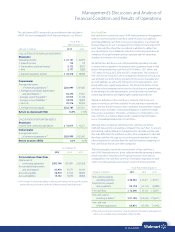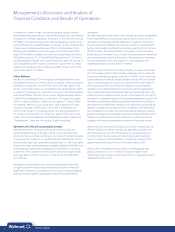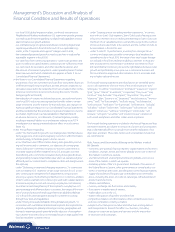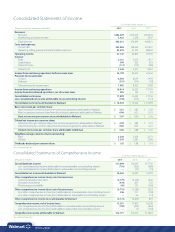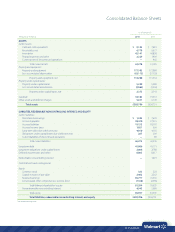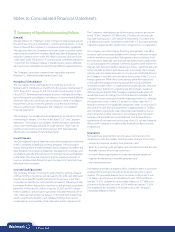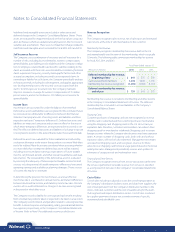Walmart 2015 Annual Report Download - page 34
Download and view the complete annual report
Please find page 34 of the 2015 Walmart annual report below. You can navigate through the pages in the report by either clicking on the pages listed below, or by using the keyword search tool below to find specific information within the annual report.
32 2015 Annual Report
Management’s Discussion and Analysis of
Financial Condition and Results of Operations
In addition to currency swaps, we have designated foreign-currency-
denominated long-term debt as nonderivative hedges of net investments
of certain of our foreign operations. At January 31, 2015 and 2014, we had
£2.5 billion of outstanding long-term debt designated as a hedge of our
net investment in the United Kingdom. At January 31, 2015, a hypothetical
10% increase or decrease in the value of the U.S. dollar relative to the
British pound would have resulted in a gain or loss in the value of the
debt of $342 million. In addition, we had outstanding long-term debt of
¥100 billion at January 31, 2015 and ¥200 billion at January 31, 2014, that
was designated as a hedge of our net investment in Japan. At January 31,
2015, a hypothetical 10% increase or decrease in value of the U.S. dollar
relative to the Japanese yen would have resulted in a gain or loss in the
value of the debt of $77 million.
Other Matters
We discuss our existing FCPA investigation and related matters in the
Annual Report on Form 10-K for fiscal 2015, including certain risks arising
therefrom, in Part I, Item 1A of the Form 10-K under the caption “Risk
Factors” and in Note 10 to our Consolidated Financial Statements, which
is captioned “Contingencies,” under the sub-caption “FCPA Investigation
and Related Matters.” We also discuss various legal proceedings related
to the FCPA investigation in Item 3 of the Form 10-K under the caption
“Item 3. Legal Proceedings,” under the sub-caption “II. Certain Other
Proceedings.” We discuss our “equal value” claims against our United
Kingdom subsidiary, ASDA Stores, Ltd., in the Annual Report on
Form 10-K for fiscal 2015, including certain risks arising therefrom, in
Part I, Item 1A of the Form 10-K under the caption “Risk Factors” and
in Note 10 to our Consolidated Financial Statements, which is captioned
“Contingencies,” under the sub-caption “Legal Proceedings.”
Summary of Critical Accounting Estimates
Management strives to report our financial results in a clear and
understandable manner, although in some cases accounting and
disclosure rules are complex and require us to use technical terminology.
In preparing the Company’s Consolidated Financial Statements, we fol-
low accounting principles generally accepted in the U.S. These principles
require us to make certain estimates and apply judgments that affect our
financial position and results of operations as reflected in our financial
statements. These judgments and estimates are based on past events
and expectations of future outcomes. Actual results may differ from
our estimates.
Management continually reviews our accounting policies, how they
are applied and how they are reported and disclosed in our financial
statements. Following is a summary of our critical accounting estimates
and how they are applied in preparation of the financial statements.
Inventories
We value inventories at the lower of cost or market as determined primarily
by the retail method of accounting, using the last-in, first-out (“LIFO”)
method for substantially all of the Walmart U.S. segment’s inventories.
The inventory at the Walmart International segment is valued primarily
by the retail inventory method of accounting, using the first-in, first-out
(“FIFO”) method. The retail method of accounting results in inventory
being valued at the lower of cost or market since permanent markdowns
are immediately recorded as a reduction of the retail value of inventory.
The inventory at the Sam’s Club segment is valued based on the
weighted-average cost using the LIFO method.
Under the retail method of accounting, inventory is valued at the lower
of cost or market, which is determined by applying a cost-to-retail ratio
to each merchandise grouping’s retail value. The FIFO cost-to-retail ratio
is generally based on the fiscal year purchase activity. The cost-to-retail
ratio for measuring any LIFO provision is based on the initial margin of
the fiscal year purchase activity less the impact of any permanent
markdowns. The retail method of accounting requires management to
make certain judgments and estimates that may significantly impact the
ending inventory valuation at cost, as well as the amount of gross profit
recognized. Judgments made include recording markdowns used to sell
inventory and shrinkage. When management determines the ability to
sell inventory has diminished, markdowns for clearance activity and the
related cost impact are recorded. Factors considered in the determina-
tion of markdowns include current and anticipated demand, customer
preferences and age of merchandise, as well as seasonal and fashion trends.
Changes in weather and customer preferences could cause material
changes in the amount and timing of markdowns from year to year.
When necessary, we record a LIFO provision for the estimated annual
effect of inflation, and these estimates are adjusted to actual results
determined at year-end. Our LIFO provision is calculated based on
inventory levels, markup rates and internally generated retail price
indices. At January 31, 2015 and 2014, our inventories valued at LIFO
approximated those inventories as if they were valued at FIFO.
We provide for estimated inventory losses, or shrinkage, between
physical inventory counts on the basis of a percentage of sales.
Following annual inventory counts, the provision is adjusted to reflect
updated historical results.



